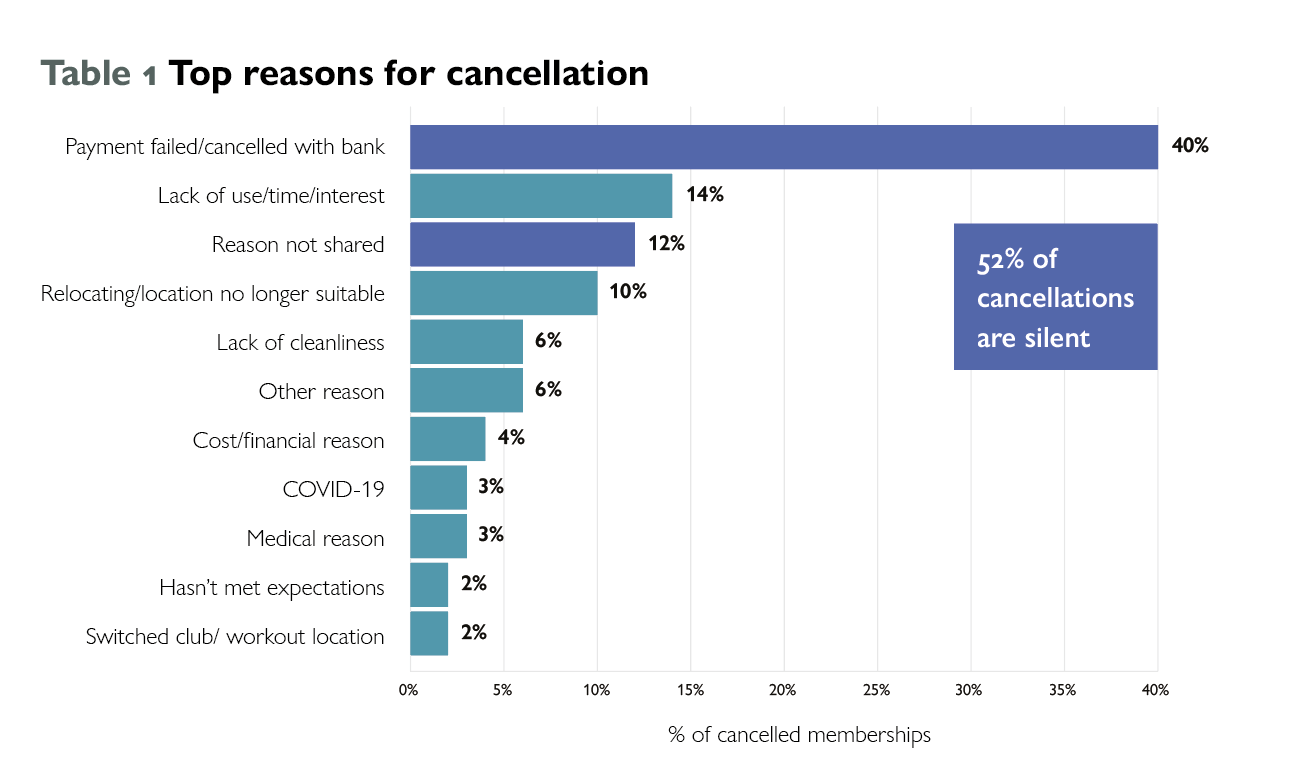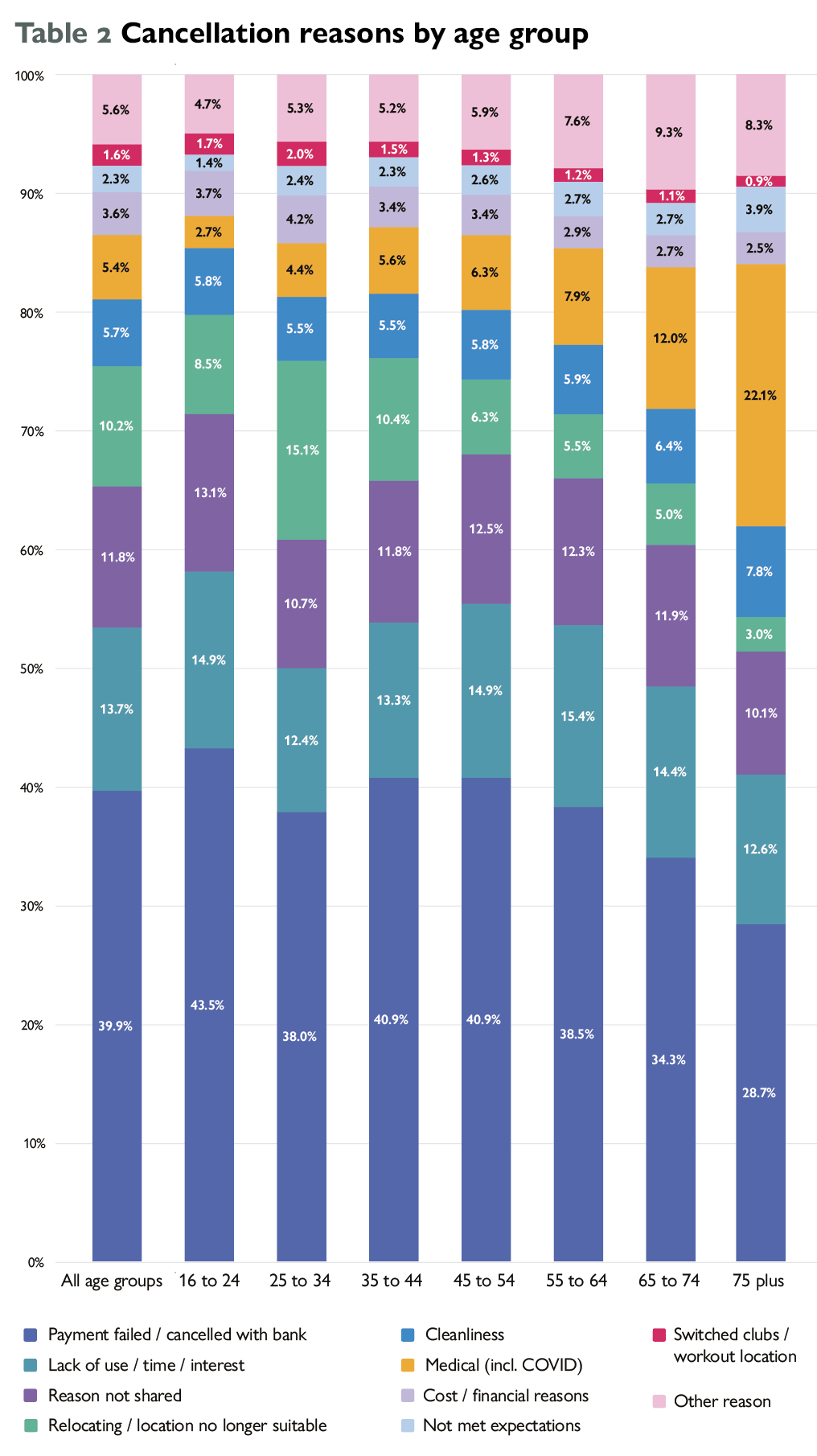Xplor has partnered with research company Active Insight – formerly Leisure-Net Solutions and consultants, GGFit, to research the state of attrition in the UK health and fitness market and provide operators with actionable insights.
The research was based on Xplor data from over 700,000 gym, health club and leisure members who pay by Direct Debit in the UK and Ireland.
The dataset includes information about 370,000 members who cancelled in the six-plus years between January 2017 and April 2023.
“Why do members leave?” Was the first question the research sought to answer, looking for common factors that contribute to attrition.
The insight team found 48 per cent of people will tell operators why they’re cancelling, with most commonly cited reasons including lack of use, lack of time and lack of interest (14 per cent), relocating (10 per cent) and dirty facilities (6 per cent) – potentially one of the most straightforward objections to resolve.
The remaining 52 per cent of the sample didn’t reveal a reason for leaving, while a huge 40 per cent left without directly cancelling with the operator, who only found out when they recorded a failed/cancelled payment.
In short, many members are quietly quitting, with those aged 16 to 24 most likely to do this by quietly walking away (57 per cent).
Differences by age
Generally older members (aged 65+) are most likely to share a reason for leaving, while among 25- to 34-year-olds, 48 per cent did not.
The life stage of 25- to 34-year-olds also means they’re more mobile, with 15 per cent leaving due to relocation, against an average of 10.2 per cent for all age groups and 3 per cent for the much more settled 75+ age group.
This younger cohort is more likely to respond to a national operator that can offer a range of locations, so they can continue their membership at a different club in the chain, rather than walking away.
Feeling let down can have an impact on retention, with those in the 75+ group more likely to leave because they feel that a health club “hasn’t met their expectations” (3.9 per cent) against the average score of 2.3 per cent across all of the age groups.
Older people are also more likely to leave if a health club is dirty, with 7.8 per cent of the 75+ group citing lack of cleanliness as their reason for cancelling, against an average of 5.7 per cent, while the people in the younger 16- to 24-year old group are less sensitive to this issue, with a lower figure of 5.8 per cent saying lack of cleanliness put them off.
Understanding reasons for cancellations can help operators make improvements that increase retention, drive sustainable growth and increase average member lifetime value.
Start with culture
Members want to feel confident to share feedback and air their dissatisfaction and need to feel that you’ll listen and then act on what you hear. The most effective way to encourage member honesty is to build a feedback culture where they have a deep connection to your club and feel they’re always heard.
“Historically many operators think they know the issues already, so don’t believe there’s any value in listening to feedback,” says Active Insight’s Julie Allen. “We really need to shift our focus as an industry to understanding that listening to clients yields vital intelligence that can be acted on to move the business forward.”
There are so many opportunities to gather feedback and make it an everyday habit for staff and customers.
Regularly survey members from the point that they join – run Net Promoter Score (NPS) surveys and discuss feedback with staff during team meetings and one-to-ones, for example.
You can also follow up on feedback to amplify impact. “Develop member feedback into regular stories – both positive and negative – to create a “You asked, we responded’’ feedback culture,” says GGFit’s Guy Griffiths. “The more you ask for feedback, the more positive stories you’ll get to share.”
Scrutinise your payment processes
The research study found that a failed payment is the most common source of membership cancellations at 40 per cent. Allen says: “Some members cancel payments directly with their payment provider rather than contacting the operator, because they’re not aware of terms they agreed or don’t understand that they needed to cancel in a specific way. Payments can also fail if a member is experiencing financial hardship and the draw-down is rejected by their bank.”
When a payment fails, priority should be given to attempting the collection again – letting the member know what’s happening and how to get in touch. Xplor’s Dave Alstead says: “Money can be an emotive topic, so a careful and skillful approach is required when dealing with people in these situations.”
Operators can also take simple measures, such as verifying payment details provided, to reduce the likelihood of failures.
Give members more control
Giving members more flexibility and control over their membership can also help prevent silent cancellations and even stop some cancellations from happening.
Consider allowing members to freeze for a period with ease. This is ideal if a member is travelling, busy with family or work commitments, or experiencing injury or illness.
Offering this option is also in line with the law, which stipulates that members can cancel if they become unwell or have a change in financial circumstances, so it’s best to preempt this.
Alstead says: “Within the law, make sure you limit the amount of time a freeze lasts for, and communicate consistently during a freeze period to encourage an early return by the member and also to maintain engagement. This is critical to get members back after a freeze.”
Part on good terms
It’s also worth exploring how you can make cancelling simpler for your members, by providing digital options to suit those who would perhaps find a direct conversation awkward or too time-consuming.
Alstead adds: “The easier you can make it for members to understand how cancellation works, the easier it will be for members to cancel in ways that work for you too and this will cause you fewer headaches further down the line.” While enabling cancellations might sound counterproductive, ending a relationship with a member on a good note leaves the door open for a return and can encourage them to share an honest reason for leaving, which in turn can strengthen the operation.
“We all know the phrase ‘first impressions count’, yet, every touchpoint of a member journey should be meaningful,” says Allen. “It’s essential that if the moment of leaving is the last interaction with the club, it’s approached positively and leaves a good lasting impression” she says.
“Cutting attrition and increasing retention helps increase average member lifetime value,” says Alstead. “This enables fitness club operators to have a more lasting impact on the health of communities they serve, while helping grow the industry beyond the current 15.1 per cent penetration rate.”
As we near the end of the year, operators are gearing up to make the most of January peak trading in the form of new joiners. The highest proportion of cancellations occur in the latter part of the year and that raises a question: how many members acquired in January 2024 will still hold their membership come December?
On the positive side, historic data from DataHub has shown that 52 per cent of members will retain their gym membership at least 12 months after signing up, so there’s ample opportunity for operators to retain more members, while attracting members who are yet to belong to a health club, as well as those returning after a break.






























































